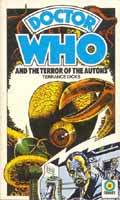Terror of the Autons
Doctor Who and the Terror of the Autons

|
Terror of the Autons |
Target novelisation Doctor Who and the Terror of the Autons |

|
| Author | Terrance Dicks |  |
| Published | 1975 | |
| ISBN | 0 426 10639 3 | |
| First Edition Cover | Peter Brookes |
| Back cover blurb: The evil Master leered at the Doctor, and triumphantly pointed out of the cabin window. The many-tentacled Nestene monster - spearhead of the second Auton invasion of Earth - crouched beside the radio tower! Part crab, part spider, part octopus, its single huge eye blazed with alien intelligence and deadly hatred... Can the Doctor outwit his rival Time Lord, the Master, and save the Earth from the Nestene horror? |
Tightened up after television - where was the script editor then? by Tim Roll-Pickering 15/12/03
On screen Terror of the Autons comes across as little more than a series of set pieces designed to introduce a new regular villain for the series whilst also producing a more light-hearted and family orientated story than seen in the previous season. It also suffers from a weak ending where the Master brings the Nestenes to Earth but then suddenly changes sides after a simple suggestion by the Doctor.
For the novelisation Terrance Dicks has taken the opportunity to tighten things up, removing superfluous comical moments (Brownrose from the Ministry has been completely removed) whilst also expanding upon the individual charecters, bringing them to life. We learn how Rex Farrel has long been a weak son trying to emerge from his overdomineering father's shadow, how Luigi Rossini runs his circus with a tight hand, Albert Goodge's opinion of his packed lunch or Jo's reaction to events around her as she begins work at UNIT. This book contains the first major breach of continuity in the novelisations as this story is now presented as Jo's debut (as on television), contradicting the earlier novelisation Doctor Who and the Doomsday Weapon. Whilst this restores a semblance of order to the novelisations, such a willingness to change television continuity in one book and not follow through in another can in the long run cause problems for anyone trying to draw sense from the books alone.
Although the emphasis in a lot of scenes is altered and there are enhancements, such as Professor Phillips being disguised as a clown purely because of the Master's sense of humour, the book makes no major changes to the structure of the stoy. But the emphasis feels a lot better here, with the result that the story comes across as more serious and less of a send-up than its television counterpart. The ending also makes a lot more sense as throughout the book there are brief moments of anger between the Master and the Auton leader, with the result that when the Doctor confronts the Master in the control tower the latter realises that he can not guarentee that the Nestenes will reward him. Furthermore the Brigadier pulls a gun on him. As a result the Master's aiding the Doctor now seems far more natural and raises the question as to why Dicks and/or Holmes did not alter the televised version to follow this. Also at the story's climax we get a far more substantial description of the Nestenes arriving than the blurred white lines seen in the sky. Here we get a description, reinforced by both Willow's illustrations and the first two covers of the novelisation, of a hideous creature that is part crab, part spider and part octopus with a single eye and comprised of pure force and energy. Again it makes the threat seem ever more real.
Doctor Who and the Terror of the Autons may have its faults in that the story does not feel as coherent as it could be, but by and large these problems arise from the original television version and short of restructuring the plot this could not be helped. As a novelisation the story works much better in the small changes it makes. But one has to wonder why the script editor of the television story did not make them at the time...7/10
A Haiku by Finn Clark 27/5/22
An early Dicks book.
He's not got lazy yet, but
The plot's trivial.